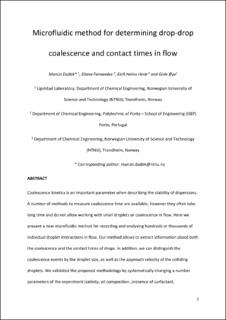| dc.contributor.author | Dudek, Marcin | |
| dc.contributor.author | Fernandes, Diana | |
| dc.contributor.author | Herø, Eirik Helno | |
| dc.contributor.author | Øye, Gisle | |
| dc.date.accessioned | 2020-03-30T15:00:33Z | |
| dc.date.available | 2020-03-30T15:00:33Z | |
| dc.date.created | 2019-12-27T11:56:53Z | |
| dc.date.issued | 2020 | |
| dc.identifier.issn | 0927-7757 | |
| dc.identifier.uri | https://hdl.handle.net/11250/2649515 | |
| dc.description.abstract | Coalescence kinetics is an important parameter when describing the stability of dispersions. A number of methods to measure coalescence time are available, however they often take long time and do not allow working with small droplets or coalescence in flow. Here we present a new microfluidic method for recording and analysing hundreds or thousands of individual droplet interactions in flow. Our method allows to extract information about both the coalescence and the contact times of drops. In addition, we can distinguish the coalescence events by the droplet size, as well as the approach velocity of the colliding droplets. We validated the proposed methodology by systematically changing a number parameters of the experiment (salinity, oil composition, presence of surfactant, temperature). The increase of salinity lead to compression of the double layer and decreased coalescence time. A difference was found when studying coalescence of heptane, xylene and dodecane, which was attributed to their hydrophobicity and viscosity. The addition of surfactant caused a significant increase of coalescence time through additional repulsion and Marangoni effect, while higher temperature caused faster coalescence of droplets. We also found that increased approach velocity generally reduced both contact and coalescence times, up to certain (critical) value. Beyond that, no coalescence was observed. | en_US |
| dc.language.iso | eng | en_US |
| dc.publisher | Elsevier | en_US |
| dc.rights | Attribution-NonCommercial-NoDerivatives 4.0 Internasjonal | * |
| dc.rights.uri | http://creativecommons.org/licenses/by-nc-nd/4.0/deed.no | * |
| dc.title | Microfluidic method for determining drop-drop coalescence and contact times in flow | en_US |
| dc.type | Peer reviewed | en_US |
| dc.type | Journal article | en_US |
| dc.description.version | acceptedVersion | en_US |
| dc.source.volume | 586 | en_US |
| dc.source.journal | Colloids and Surfaces A: Physicochemical and Engineering Aspects | en_US |
| dc.identifier.doi | https://doi.org/10.1016/j.colsurfa.2019.124265 | |
| dc.identifier.cristin | 1763941 | |
| dc.description.localcode | © 2019. This is the authors’ accepted and refereed manuscript to the article. Locked until 22.11.2021 due to copyright restrictions. This manuscript version is made available under the CC-BY-NC-ND 4.0 license http://creativecommons.org/licenses/by-nc-nd/4.0/ | en_US |
| cristin.unitcode | 194,66,30,0 | |
| cristin.unitname | Institutt for kjemisk prosessteknologi | |
| cristin.ispublished | true | |
| cristin.fulltext | preprint | |
| cristin.qualitycode | 1 | |

